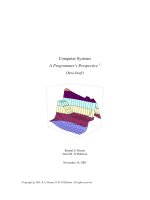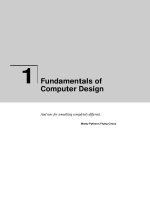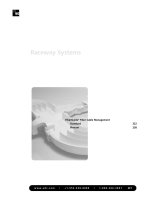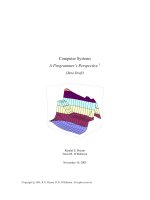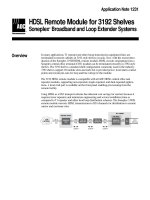Computer Systems docx
Bạn đang xem bản rút gọn của tài liệu. Xem và tải ngay bản đầy đủ của tài liệu tại đây (24.4 MB, 54 trang )
Computer Hardware
Computer Hardware
Chapter 2
Chapter 2
Chapter 2: Computer Hardware 2
2
Chapter Contents
Section A: Personal Computer Basics
Section B: Microprocessors and Memory
Section C: Storage Devices
Section D: Input and Output Devices
Section E: Hardware Security
Chapter 2: Computer Hardware 3
2
SECTION
A
Personal Computer Basics
Personal Computer Basics
Personal Computer Systems
Desktop and Portable Computers
Home, Media, Game, and Small Business
Systems
Buying Computer System Components
Chapter 2: Computer Hardware 4
2
Personal Computer Systems
Chapter 2: Computer Hardware 5
2
Desktop and Portable Computers
The term form factor
refers to the size and
dimensions of a
component, such as a
system board or
system unit
A desktop computer fits
on a desk and runs on
power from an electrical
wall outlet
Chapter 2: Computer Hardware 6
2
Desktop and Portable Computers
A portable computer is a small, lightweight
personal computer
A notebook computer (also referred to as a
laptop), is a small, lightweight portable
computer that opens like a clamshell to
reveal a screen and keyboard
A tablet computer is a portable computing
device featuring a touch-sensitive screen that
can be used as a writing or drawing pad
Chapter 2: Computer Hardware 7
2
Desktop and Portable Computers
Chapter 2: Computer Hardware 8
2
Home, Media, Game,
and Small Business Systems
A home computer system offers a hardware
platform with adequate, but not super-
charged support for most computer
applications
Some of the most cutting-edge computers
are designed for gaming
Computers marketed for small business
applications tend to be middle-of-the-line
models pared down to essentials
Chapter 2: Computer Hardware 9
2
Buying Computer
System Components
Decide how your computer will be used, and
how much you want to spend
Decide on a platform (Mac, PC, Linux)
Look at ads in computer magazines and at
computer/electronic stores
Understand the computer jargon
Expect to pay anywhere from a few hundred
to several thousand dollars
Chapter 2: Computer Hardware 10
2
Buying Computer
System Components
Instead of buying a new computer, you might
consider upgrading
Chapter 2: Computer Hardware 11
2
SECTION
B
Microprocessors and Memory
Microprocessors and Memory
Microprocessor Basics
Today’s Microprocessors
Random Access Memory
Read-only Memory
EEPROM
Chapter 2: Computer Hardware 12
2
Microprocessor Basics
Microprocessor
clock
–
Megahertz
–
Gigahertz
Cache
–
Level 1 cache (L1)
–
Level 2 cache (L2)
Chapter 2: Computer Hardware 13
2
Today’s Microprocessors
Chapter 2: Computer Hardware 14
2
Random Access Memory
Random Access Memory is a temporary
holding area for data, application program
instructions, and the operating system
Chapter 2: Computer Hardware 15
2
Random Access Memory
Microscopic capacitors hold the bits that
represent data
Most RAM is volatile
–
Requires electrical power to hold data
Chapter 2: Computer Hardware 16
2
Random Access Memory
RAM capacity is expressed in megabytes or
gigabytes
Personal computers typically feature
between 256MB and 2GB of RAM
An area of the hard disk, called virtual
memory, can be used if an application runs
out of allocated RAM
Chapter 2: Computer Hardware 17
2
Random Access Memory
RAM speed is often expressed in
nanoseconds or megahertz
SDRAM is fast and relatively inexpensive
–
DDR
RDRAM is more expensive, and usually
found in high-performance workstations
Chapter 2: Computer Hardware 18
2
Read-Only Memory
ROM is a type of memory circuitry that holds
the computer’s startup routine
–
Permanent and non-volatile
The ROM BIOS tells the computer how to
access the hard disk, find the operating
system, and load it into RAM
Chapter 2: Computer Hardware 19
2
EEPROM
Electrically Erasable
Programmable Read-
Only Memory
More permanent than
RAM, and less
permanent than ROM
Requires no power to
hold data
Chapter 2: Computer Hardware 20
2
SECTION
C
Storage Devices
Storage Devices
Storage Basics
Magnetic Disk and Tape Technology
CD and DVD Technology
Solid State Storage
Storage Wrap-up
Chapter 2: Computer Hardware 21
2
Storage Basics
A storage medium contains data
A storage device records and retrieves data
from a storage medium
–
Data gets copied from a storage device into
RAM, where it waits to be processed
–
Processed data is held temporarily in RAM
before it is copied to a storage medium
Chapter 2: Computer Hardware 22
2
Magnetic Disk and
Tape Technology
Magnetic storage stores data by magnetizing
microscopic particles on the disk or tape
surface
Chapter 2: Computer Hardware 23
2
Magnetic Disk and
Tape Technology
Hard disk platters and read-
write heads are sealed inside
the drive case or cartridge to
screen out dust and other
contaminants.
Chapter 2: Computer Hardware 24
2
A controller positions the disk and read-write
heads to locate data
–
SATA
–
Ultra ATA
– EIDE
–
SCSI
Not as durable as many other storage
technologies
–
Head crash
Magnetic Disk and
Tape Technology
Chapter 2: Computer Hardware 25
2
CD and DVD Technology
Optical storage stores data as microscopic
light and dark spots on the disk surface
–
CD and DVD storage technologies
